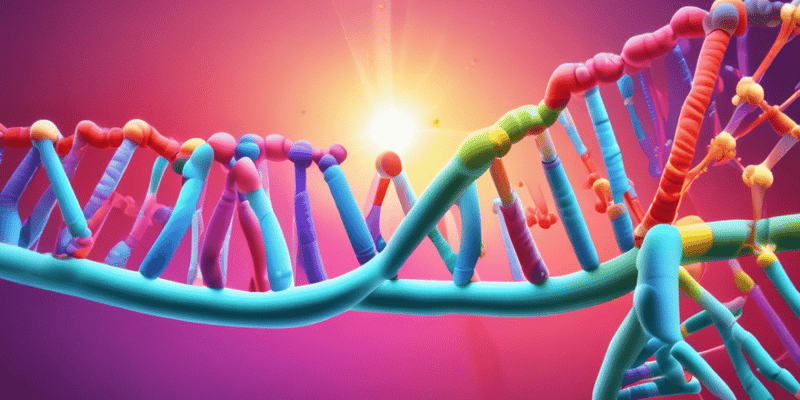26 Questions
Who discovered the DNA structure?
Watson and Crick
What is the genetic material identified as, according to the DNA research in 1944?
DNA
What were the experiments by Avery, MacLeod, and McCarty focused on?
Transfer of genetic information by DNA
What was initially thought to be genes?
Proteins
What is the main goal of the Human Genome Project initiated in 1990?
To determine the entire human genome sequence
Who discovered the double helix structure of DNA in 1953?
Watson and Crick
What are the two types of nucleic acids mentioned in the text?
DNA and RNA
What are the bases connected by in the double helix structure of DNA?
Hydrogen bonds
What is the hereditary material in all living cells?
DNA
When was the Human Genome Project completed?
2000
What do the bases form within the double helix structure of DNA?
Specific pairs
What is the main difference between DNA and RNA?
The sugar component
What is the role of DNA as mentioned in the text?
Storing the genetic code in cells
What did scientists begin giving significant attention to in 1944?
DNA as the genetic material
What was the significant outcome of the Human Genome Project?
Discovery of the entire human genome sequence
What is a nucleotide composed of?
Nitrogenous bases, a 5-carbon sugar, and a phosphate group
What is the structure of a nucleotide?
A base linked to a sugar and a phosphate group
Where is the phosphate group attached in a nucleotide?
5’ carbon of the nucleoside
How are nucleic acids formed from nucleotides?
Condensation reaction creating a phosphodiester bond
What is the key feature of base pairing in nucleic acids?
Complementary bases bonded together by hydrogen bonds
What type of structure do nucleic acids have?
Double-stranded with complementary polynucleotide chains joined by hydrogen bonds
What are the different forms of nucleic acids referred to in the text?
B-form, A-form, and Z-form
What process allows DNA and RNA to separate into single strands and reform double strands?
Denaturation and renaturation
How is RNA structured?
Single-stranded, except for some secondary structures formed by intramolecular hydrogen bonding
What role does RNA play in protein synthesis?
(RNA plays a role in protein synthesis through the action of mRNA, tRNA, and rRNA)
What are non-coding RNAs (ncRNAs) involved in?
Regulating gene expression and various epigenetic processes
Study Notes
- Nucleic acids are composed of nucleotides, which are made up of a nucleoside (a base linked to a sugar) and a phosphate group.
- Nucleotides have a phosphate group attached to the 5’ carbon of the nucleoside, and a free hydroxyl group at the 3’ end.
- Nucleic acids are polymers of nucleotides formed by a condensation reaction that creates a phosphodiester bond between the 5’ phosphate group of one nucleotide and the 3’ hydroxyl group of another.
- Base pairing is a key feature of nucleic acids, with complementary bases (A pairs with T and C with G) bonded together by hydrogen bonds.
- Nucleic acids have a double-stranded structure, with two complementary polynucleotide chains joined together by hydrogen bonds (A-T and C-G).
- Nucleic acids come in different forms, such as B-form, A-form, and Z-form, each with distinct structures and properties.
- DNA and RNA can denature (separate into single strands) and re-anneal (reform double strands) through a process called denaturation and renaturation.
- RNA is a single-stranded nucleic acid, with the exception of some secondary structures formed by intramolecular hydrogen bonding.
- RNA plays a role in protein synthesis through the action of messenger RNA (mRNA), transfer RNA (tRNA), and ribosomal RNA (rRNA).
- Non-coding RNAs (ncRNAs) function to regulate gene expression and are involved in various epigenetic processes.
Test your knowledge on DNA structure and genetics with this quiz. Explore milestones in DNA research, eukaryotic and prokaryotic cells, and the genetic material carried by DNA that identifies all properties of living organisms.
Make Your Own Quizzes and Flashcards
Convert your notes into interactive study material.
Get started for free


